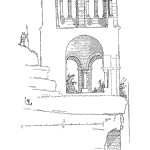
Mechanical drawings and electrical schematics communicate the design.
They provide information sufficient to create a product or build a system.
They provide the necessary details that allow others to construct something that originally was only imaged.
We no longer rely on a single craftsman to build a chest of drawers from concept to delivery.
Instead, they may be a team scattered across many organizations relying on the drawings.
Included on the drawings and schematics are dimensions along with tolerances. A keypad will be a specific width, plus/minus some amount. A resistor is nominally 100 ohms, yet anything between 90 and 110 ohms is fine.
Tolerances acknowledge the variability between individual components or caused during the construction process.
Tolerances also impact the reliability performance of your products.
Perfect parts
No two parts, even from the same material batch, molding machine, etc, are identical. Look closely enough and the width is different.
If we could create identical parts all the time, we would not need tolerances.
We would not require a range of acceptable dimensions.
Since part vary, we use tolerances to convey the acceptable variation.
If parts are within the tolerance range of the various dimensions, then the assembled product should work as expected.
Tight tolerances
A design may require a tight tolerance for a specific part.
The nature of the design or the design intent expects each part to be nearly identical.
The tight tolerance may be no problem.
The assembly process has the capability and does not incur an extra cost or an increase in scrap. In other situations, you may resort to inspecting every part and sorting for those meeting the specified tolerance.
If you are able to consistently create parts meeting the tight tolerances, that may actually improve the system’s reliability.
Loose or ill-fitting parts tend to reduce the functional life of a product, which can be avoided by meeting tight tolerances.
On the other hand, the tight tolerance may not be physically possible to accomplish.
Besides increased inspection and costs, the probability out of tolerance parts make their way into a product is relatively high.
Inspection error and test escapes are just two ways to use an out of tolerance part.
The tolerance itself may be a compromise between an even tighter tolerance and the manufacturing capability.
The design would function well when the part meets the very tight preferred tolerance, yet to avoid scrape or extra burden of rework, etc.
The tolerance may be widened, thus degrading the reliability performance.
Tight tolerances present increased risk.
Loose tolerances
The opposite of tight tolerances is loose tolerances.
Wider ranges of acceptable part dimensions permit, at times, less expensive fabrication and assembly methods.
In some parts of your design a looser, or wider, tolerance is perfectly acceptable.
The product functions as expected and doesn’t increase the risk of failure over time.
In some parts of the system, a looser tolerance allows the system to rattle, for example.
The unnecessary motion creates an additional stress on the system. It may also be classified as a failure by the customer not expecting a rattling sound.
Setting the right tolerance is a balance of functional needs, fabrication capability, and reliability.
Consider costs and design intent, to make setting tolerances an important and complex element of your designs.
Poorly created tolerances
When crafted poorly, tolerances adversely impact suppliers, assembly, functionality, and reliability of a product.
When a part is not specified correctly, the supplied part even if it meets the stated tolerances may lead to product or reliability failures.
When a part fails, it often the supplier that receives the first round of scrutiny.
The assembly becomes difficult generally decreasing yield, thus increasing costs.
The functionality suffers. A part that should have a tight tolerance doesn’t mean the door may not close, for example.
The reliability suffers as the system experiences unnecessary stresses due to improperly sized parts.
Well balanced tolerances
Well crafted tolerances considering:
- Component manufacturing capability
- Inspection or sorting or yield costs
- Functionality and design intent
- Long-term performance (reliability)
- Customer perception of product quality
It takes time, yet crafting tolerances provide benefits across the product generation and use lifecycle.
A system created using the correct tolerance for each element, increases the ability of the design to be manufactured and employed, meeting customer expectations.
Tolerances communicate the acceptable range of component parameters.
They also enable the design to function over time. Done well, it improves reliability performance.
How do you see the connection between tolerances and reliability? Please leave a comment below.
Related:
Purpose of Tolerances (article)
Reliability and Tolerance Analysis (podcast)
Inputs to Consider When Setting Tolerances (article)
Leave a Reply